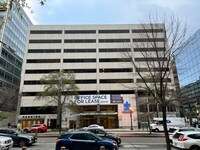Regarding the Nov. 26 editorial, “In need of a resurrection”:
How to improve downtown D.C.

F Street NW in front of the National Portrait Gallery — close to shopping, restaurants, housing and transit — should become a permanent public plaza, closed to traffic, with seating and food trucks. A design competition could generate inspiring proposals by exceptional local and international talent. However, I do believe a minimalist approach to any urban design intervention could avoid the mistakes of the previous over-designed and under-maintained pedestrian mall, ripped up a quarter century ago.
Similar gathering spaces with event programming, food options and seating could activate other areas of downtown and support nearby businesses.
John Peck, Arlington
The Nov. 26 editorial, though well intentioned in terms of the revitalization of downtown D.C., made some surprisingly poor and outdated recommendations related to the future of work for the federal workforce.
The editorial stated numerous times that workers should be forced back into the office three days a week, across all agencies, in a blanket, top-down mandate. This was not based on what is best for the worker, the agency or the mission, nor did it acknowledge the “new normal” of hybrid/telework that the government needs to support to stay competitive. Instead, it was solely based on using the federal workforce to cover for government and contractor rent in D.C., and some perceived notion that eating lunch and drinking at happy hour will save the city.
The federal workforce should not be used as a pawn to revitalize a city that refuses to reinvent itself. The future of work is here, like it or not, and the second half of the editorial rightfully admitted this and focused on bold new ideas — while acknowledging the many workers who can do their jobs remotely. The future of work is also not the one-size-fits-all approach that was recommended here (even for one agency or within an agency). It is quite shocking to see these pre-pandemic, outdated stances on this.
Joe Santanello, Alexandria
The Nov. 26 editorial failed to mention an important step that D.C. could take to encourage the return of commuting workers and their tax dollars to the city: Stop making driving through the city harder.
Over the past several years, D.C. has constructed a network of bus lanes, bike lanes, traffic islands, restaurant venues and other devices that have made trips into and through town a nightmare. On Tuesdays, when “everybody” comes to the office, the commuting roads and downtown streets are awful. It’s going to get worse if D.C. moves ahead with its dangerous plan to install bike lanes on Connecticut Avenue.
Rather than navigate the obstacle course that D.C. has erected, people with the option are going to stay away. Time for the city to roll up its Not Welcome mat.
Paul Kiernan, Chevy Chase
It was good to see the Nov. 26 editorial supporting conversions of commercial buildings to apartments in downtown. It is the duty of D.C., which receives millions in federal dollars, to have all conversions include living units for low- and moderate-income families. This requires two-, three- and four-bedroom bedroom units. D.C. Mayor Muriel E. Bowser (D) has utterly failed in creating affordable housing, as required under the Fair Housing Act, Housing and Community Development Act and Affirmatively Furthering Fair Housing regulation.
This resurrection can be the way to incorporate racial and economic integration into our neighborhoods. D.C. signed agreements with the Department of Housing and Urban Development promising to use Community Development Block Grant funds and other federal dollars to create affordable housing for decades. Yet new high-rises didn’t provide affordable units to families, especially families displaced by developers. D.C. Council members should require enforceable agreements before development plans and occupancy permits are approved, and secure proof that low- and moderate-income families have units.
Shanna L. Smith, Washington
The writer was chief executive of the National Fair Housing Alliance headquartered in D.C. from 1990 to 2018.
I suggest developers consider revamping some empty office buildings into what many federal and other retirees have been looking for: an urban senior community close to restaurants, shops and younger people. So many senior communities are parked out in the suburbs or beyond, designed to be their own little oases that consequently require driving to go anywhere. I would like to move on my own two feet and on Metro to see friends, family and museums, while also benefiting from the services that senior centers provide.
Most people my age blanch at the thought of checking themselves into a senior community, but a center set in a vibrant urban area could become a mecca for those of us who want to enjoy and contribute to life until we can’t — and spend some money while we’re at it. The only other thing I’d like as part of a move to D.C.: representation in Congress!
Nancy Ketcham-Colwill, Arlington






